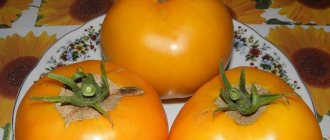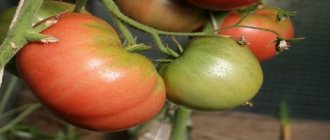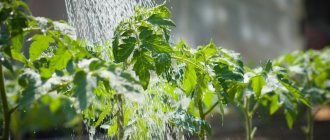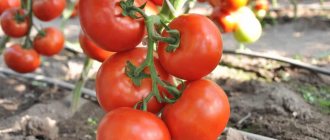Description of the variety
The Sugar Giant tomato is an “amateur selection” variety; its description varies among different seed producers. The main differences relate to the shape of the fruit and the timing of ripening. Most amateur agronomists classify heart-shaped tomatoes with late ripening as this variety.
Bush
The plant belongs to the indeterminate type, reaches a height of 1.8-2 m in greenhouses and 1.5 m in open beds.
The foliage is medium, the leaves are large and dark green. The stems are thin and require garter. The education of stepchildren is moderate.
The first inflorescence forms above the ninth leaf, the rest grow through two internodes. Each cluster bears 4-6 fruits. The sugar giant actively forms fruit ovaries, regardless of weather conditions.
The fruiting period is long, in greenhouses - until early October, in the open air - until frost.
Fruit characteristics and yield
The sugar giant is a late-ripening species. The first marketable tomatoes ripen 125-130 days after emergence.
The fruits are heart-shaped, red, with dense fleshy pulp and thin skin. On the cross-section you can see a small number of seed chambers without a hard core. The fruits are large, on average their weight is 300-350 g, when grown in one stem it can reach 500-600 g. Tomatoes have excellent taste and high sugar content, but are difficult to store and transport.
The yield of the variety is high: summer residents harvest 3-4 kg per bush, and with the right agricultural technology, a harvest of up to 5-6 kg is possible.
Characteristics of the Pink Giant tomato
Tomatoes reach technical ripeness 4 months after planting the seeds, that is, around the beginning of July. Peak fruiting occurs at the end of the month and the beginning of August. Green tomatoes can be sent to ripen in a dark place or left to ripen on a branch, making a reliable support.
Pink giant tomato productivity and fruiting
The variety is high-yielding - up to 5 kg of fruits are harvested from 1 bush per season.
| Growing method | Greenhouse | In the garden |
| From 1 bush, kg | 4-5 | 3-4 |
| From 1 m2, kg* | 12-15 | 9-12 |
*It is recommended to plant no more than 3-4 Pink Giant tomato bushes per 1 m2.
To harvest as many tomatoes as possible, it is better to plant the plants in a greenhouse (especially in regions with an unfavorable climate). In addition, it is necessary to follow standard growing rules:
Regular, moderate watering. Feeding. Forming a bush with 2 stems, carrying out pinching. Tying to a support. Once the fruit begins to set, it is important to pinch the crown.
Important! When growing Pink Giant tomatoes indoors, the greenhouse must be ventilated regularly, especially in hot weather and during watering
Area of application of fruits
Pink giant tomatoes are classified as salad varieties - they are consumed fresh. Also suitable for preparing various dishes:
- sauces;
- soups;
- second courses;
- tomato juice.
The fruits are also used for processing:
- tomato puree;
- ketchup;
- lecho;
- squash caviar and other preparations.
However, these tomatoes are not suitable for canning - they are too large. In addition, the soft skin does not withstand long-term storage - it will inevitably crack.
Resistance to diseases and pests
The pink giant has average immunity - as a rule, the bushes are not susceptible to late blight, rot and other diseases of the Solanaceae. But this threat should not be completely ruled out. Therefore, as a preventative measure, it is recommended to observe the watering norm and ventilate the greenhouse. Another measure is to treat the seedlings with fungicides (before transplanting into the ground). In summer, insects can parasitize Pink Giant tomato bushes. To combat them, folk remedies and insecticides are used.
Seed preparation
Regardless of the source of seeds (your own or purchased), to obtain a good harvest, three operations must be performed before planting.
Rejection
Its goal is to select viable, “full” seeds. To do this, dissolve a teaspoon of salt in a glass of water, place the seed there and stir for 10-15 minutes. The floating seeds are discarded. The mixture with the remaining seeds is filtered, the seeds are washed with clean water.
Disinfection
It is carried out to remove fungal spores and pathogenic microorganisms. To do this, the seed material is soaked in one of the disinfecting solutions for 30 minutes:
- 1% potassium permanganate, light pink;
- 3% hydrogen peroxide – accelerates seed germination;
- "Fitosporin" (according to the instructions).
Germination
Calibrated and disinfected seeds are laid out on damp material. To maintain constant humidity, they are covered with plastic wrap and placed in a warm (22-25 degrees) place. After five days, white roots appear - the seeds are ready for planting.
Diseases and pests
It is impossible to describe the reaction to pathogens and pests of different varieties. However, the fact is obvious that carrying out preventive measures makes it possible to obtain a harvest under any sensitivity of the variety and in any weather conditions.
Experienced vegetable growers fulfill a number of strict requirements when carrying out treatments:
- the first spraying is carried out during the budding period, then every 15-20 days, depending on humidity indicators;
- treatment is carried out with constant alternation of fungicidal preparations, which will not allow microscopic fungi to develop resistance;
- Fungicide solutions are prepared only in accordance with the instructions and before use.
Planting seedlings
Tomato is grown only by seedling method.
Soil preparation
The soil for seedlings should be nutritious in composition, light and breathable. The optimal soil for growing seedlings is a mixture of turf soil, sand and peat with the addition of complex fertilizers and a moisture regulator - vermiculite.
There are special mixtures for seedlings of nightshade crops; they already contain a balanced composition of the necessary ingredients and are disinfected.
If preference is given to your own soil, then it is advisable to formulate the composition in accordance with the recommendations and be sure to disinfect it.
To do this, use one of three methods:
- Soak the soil with a pink solution of potassium permanganate.
- Treat with a solution of brilliant green: 10 drops of the product per 1 liter of water.
- Calcinate in the oven at a temperature of 120-150 degrees for at least an hour.
Sowing
If there are a large number of seedlings, the seeds are sown in flat containers with drainage holes or a drainage layer at least 2-3 cm thick. Such plantings must subsequently be planted. The seeding pattern is 4x3 cm with a depth of 1 cm.
If there are few seedlings, it is better to immediately sow the seeds in separate small containers. As the seedlings grow, they are transplanted by transferring them into larger vessels.
With each transplant, the plant is buried down to the lower leaves. This causes additional roots to grow and prevents the seedlings from becoming too elongated. Transshipment three times increases the root system five times!
Important ! Containers must be treated with any disinfectant before filling with soil.
Care
During the growth period, seedlings must be provided with optimal conditions:
- good illumination for at least 10 hours a day, including special phytolamps;
- temperature: 18-25 degrees during the day and 13-17 degrees at night;
- sufficient watering without water getting on the stem at the surface of the ground to avoid “black leg”;
- high air humidity, which is provided by humidifiers or daily spraying of plants.
How to grow tomatoes
Seedlings are planted in open ground or a greenhouse at the age of 60 days.
Landing
An additional condition for planting in open ground is the soil temperature: it must be at least 15 degrees.
To increase the yield by 1.5-2 times, it is recommended to plant the seedling horizontally with the trunk buried - this ensures additional root formation.
Plants are planted using this method at a distance of 70-80 cm in a row, row spacing is 30-40 cm, seedlings are planted in a checkerboard pattern.
With the traditional method, the planting pattern is 60x60 cm.
Care
The sugar giant can easily withstand short-term drying out of the soil, while waterlogging leads to rot and cracking of the fruit.
Weeding and loosening are part of the mandatory procedures for caring for tomatoes: their roots should receive as much air as possible. These operations can be reduced if you mulch the soil around the bushes. Grass clippings, wood shavings, and perlite are used as mulch.
In greenhouses it is recommended to form the Sugar Giant into two trunks, in open ground - into one. Accordingly, constant pinching and gartering of not only the stems, but also the brushes is required.
The sugar giant is very responsive to feeding. Only with a sufficient amount of fertilizer can you count on a good harvest.
During the growing season, at least three feedings should be carried out:
- Complete complex fertilizer 7-10 days after planting seedlings.
- Before flowering - a phosphorus-potassium mixture with a slight addition of nitrogen.
- Two weeks after the end of flowering - superphosphate and potassium nitrate. During this period, nitrogen fertilizers are prohibited!
In the intervals between these feedings, the bushes can be pollinated with wood ash and foliar feeding with superphosphate.
Features and possible difficulties
A distinctive feature of the variety is that the formation of the upper ovaries begins only after the tomatoes ripen on the lowest (first) cluster. If the first cluster is removed at the end of flowering, the period of setting the remaining fruits is noticeably shortened and the tomatoes are more uniform in size.
Due to its high growth and thin stem, the tomato must be tied up and supported under the branches. This will serve as additional protection from the wind if the plant is grown in open ground. Especially large tomato clusters require special support.
Cracking of ripe fruits during ripening is not a distinctive feature of the variety, but most often this occurs in open ground conditions with unbalanced watering. Greenhouse and greenhouse fruits of the Sweet Giant are not prone to peel rupture. To prevent cracking, the soil is enriched with saltpeter and watering is reduced during fruiting.
Diseases and pests
Experienced gardeners use protective measures against nightshade diseases, which include:
- spraying with biofungicides, such as Fitosporin, Gamair, Alirin-B, 1% Bordeaux mixture;
- the use of growth stimulants to improve immunity;
- planting nursery plants: marigolds, garlic, marigolds, nasturtiums.
Constantly ventilating greenhouses helps slow the spread of diseases.
Tomato pests - whiteflies, aphids, spider mites - are effectively destroyed by enteric-contact insecticides: Fufanon, Karbofos, Confidor.
Feed tomatoes every 2 weeks
| Stage 1. Planting seedlings Step 1. Carry out the work in early May. Add fertilizer to the soil and dig it up. Step 2. Plant the tomatoes according to a 60x70 cm pattern. Water the plants generously | |
| Stage 2. Watering Step 1. A day before work, pour water into containers to let it settle and heat up. Step 2: Water your tomatoes once a week after sunset. Watering rate per bush – 6-7 l | |
| Stage 3. Loosening Step 1. Loosen the soil after each watering. Step 2. Weed twice a month | |
| Stage 4. Feeding Step 1. Purchase a complex mineral fertilizer and composition for foliar feeding. Step 2. Apply bait once every 2 weeks. Alternate complex fertilizer and spraying of tomatoes for the best effect | |
| Stage 5. Tying Option 1. A crossbar is fixed above the plants. Plants are tied to it with twine or strips of fabric, as in the example in the photo. Option 2. A peg is driven in near each bush, to which the stem and flower brushes are tied. | |
| Stage 6. Harvest Step 1: Pick tomatoes as they ripen to relieve stress on the plant. Step 2. Remove all damaged and rotten fruits from the area |
The nuances of growing in open ground and greenhouses
To extend the growing season of a late-ripening variety in open ground, you can plant seedlings in the soil two weeks earlier, but using temporary shelters from the night cold. They are portable frames and covering material such as spunbond. A month before the onset of autumn cold, it is necessary to remove new flower ovaries - this will allow the remaining ones to reach a mature state.
The same is done with greenhouse plants, but at a later date.
Features of cultivation
In open ground, Sugar Giant tomatoes have good yields only in the southern regions of the country. In the northern regions, the fruits will not have time to fully ripen before the onset of autumn cold weather. Tomatoes do not last long, so for full ripening and good transportation, they are removed slightly reddened.
In temperate climates, the crop does not grow so tall, and tomatoes are small in size. In these regions, the variety is grown mainly in greenhouse conditions. Tomatoes planted in a greenhouse bring a bountiful harvest.
Growing seedlings
The Sugar Giant variety is grown in seedlings. The optimal time for sowing seeds is mid-March, then next month the sprouts can be transplanted into a bed in a greenhouse. Seedlings will need 65-70 days to gain strength and form a root system.
Indeterminate varieties of tomatoes are sown in separate containers: this will facilitate the future process of picking and transplanting sprouts. In order for the seedlings to form strong and healthy, you need to choose the right soil for sowing the seeds. The soil must be breathable, free from pathogenic microorganisms, have good water permeability and contain useful microelements.
You can use purchased land that is intended for growing seedlings, or prepare it yourself. To do this, mix garden soil, sand and peat in equal proportions. In this case, the earth must be calcined in the oven. This procedure will help clear it of fungal spores.
Before sowing the seed, it is treated with potassium permanganate. The seeds are soaked in the solution for several hours, after which they are dried in a warm place.
A description of the sowing process will help you do everything correctly:
- Pour pre-prepared soil into disposable containers. Then carefully place the seeds into the soil. Do this not very deeply, but not less than 1.5-2 cm;
- to evenly moisten the soil, spray it with water using a spray bottle;
- containers with seeds should be covered with polyethylene. This will create a greenhouse effect, which will help the sprouts develop much faster;
- keep the seedlings in a dark place at an air temperature of 23-25 ° C until small sprouts appear;
- after this, the seedlings should be taken out into the light and the film should be removed. Make sure that young plants receive timely moisture.
In order for Sugar Giant tomato seedlings to develop healthy, you need to carefully monitor its condition. Fungal diseases arise as a result of disturbances in temperature and humidity. For preventive purposes, seedlings are treated with ash. If you grew seedlings in one large container, do not forget to pick.
Seedlings are picked when 2-3 true leaves appear on the plants. When picking, pinch the root so that the root system develops stronger.
Transplanting seedlings
Tomatoes need good care
The seedlings are placed in a greenhouse or garden bed when the threat of sudden temperature changes has passed and the soil has warmed up to 10-12 °C. You need to prepare in advance the area where you are going to plant seedlings. Remove weeds and fallen leaves from last year's season that have remained in the garden over the winter.
():
The soil for planting vegetables, including tomatoes, is prepared in the fall. It is dug up with the addition of organic (manure, dry chicken droppings) and mineral (superphosphate, potassium salt) fertilizers. In the spring it is loosened and beds are prepared for planting.
Carefully dig up the soil and fertilize it with organic matter (humus, ash and tree peat). Dig holes that are small in diameter. Before planting, water the soil and apply fertilizer. For these purposes, it is allowed to use compost or manure.
A week before transplanting, stop watering the seedlings: this will keep the root system of the plants intact. Before moving the Sugar Giant seedlings to the garden bed, they need to be hardened off. For 10 days, take the containers with seedlings out into the open air, leaving them for 20-30 minutes at first, gradually increasing this time to 10-12 hours.
When planting sprouts in the ground, keep the same distance between the bushes (55-60 cm). Try to maintain at least 76 cm between rows. When planting, seedlings are deepened into the soil exactly up to the first leaves.
Advantages and disadvantages of the variety
Sugar giant tomatoes contain increased amounts of lycopene. This substance helps fight heart disease and rejuvenates the skin.
Other advantages of the variety:
- Excellent taste, dense pulp, strong fruit aroma.
- Long fruiting period.
- Abundant ovaries even in unfavorable conditions.
- Can be grown from your own seeds.
Flaws:
- Weak branches and trunk that cannot support the weight of the fruit.
- Labor-intensive care.
- Low keeping quality and transportability.
What vegetable growers say about the variety
Anyone who reads reviews about tomato giants will want to enjoy delicious tomatoes. Their pulp is so sweet that it is happily used to make tomato juice and sauces. After eating large fruits, everyone will conclude that we grow only this variety of red tomatoes. They are useful, they contain a lot of the substance lycopene, which serves to prevent cancer and strengthen the immune system.
The plant is resistant to temperature changes, resists tomato diseases well, and is easy to care for.
Reviews
Vegetable growers who have grown Sugar Giant on their plots are mostly satisfied with the variety, especially praising the taste and size of the fruit. The main reason for negative and neutral reviews is the misgrading of seeds by seed companies.
Ekaterina, Orsha: “The sugar giant, which has a heart, is sweet, juicy and simply amazing! This year I planted only one bush, but next year there will definitely be several bushes. I have prepared my own seeds. In terms of stability - like all late varieties. Well, what can you expect from it? It’s not a hybrid. Process it, don’t be lazy.”
Galina, Lipetsk: “My Sugar Giant seeds were from Sibsad.” Something has grown. Apparently, it's a re-sort. No taste, no harvest, some clumsiness. No desire to repeat.”
Matilda, Minsk: “I have long been looking for late, tasty tomatoes with a long season, so as not to “perish” under the tomato mass that ripened at once. I planted the sugar giant this year and liked it: I left it in the greenhouse, the tomatoes hung until October. They knit well, I just had time to tear off the ovaries and tie up the tassels. The taste is amazing."











